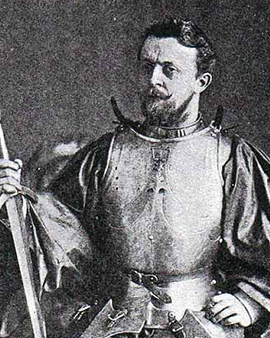


Paul Hardy had been born in Bath on 2 August 1862. Bath was already the largest city in the southern English county of Somerset with a formative culture during the lifetime of the painter and illustrator. Hardy was the son of David Hardy and Emely Hardy, who had him baptized as Paul Frederick Hardy. Both his father and grandfather were also artists. When the time came, Paul went to school in Clifton, West Yorkshire. In 1886 he had settled in the southwest London district of Chelsea, and two years later he married. Back in the country, more precisely in the small town of Storrington, Hardy designed the weather vane of a sailing ship. Today it is kept as one of the artist's first works in St. Mary's Church in Storrington.
In 1890 Hardy had made a portrait of Henry VIII. Together with a second, little known painting, there are only two works of the artist from the time up to 1905 in the renowned fund of the Royal Academy of Arts in London. In these years, Hardy was considered as an admirer of the British Renaissance humanist Sir Thomas More. He had also acquired special skills in the field of artistic metalworking. Paul Hardy, for example, made his own armour, a plate armour as a replica after old models. On this basis, the artist advanced to become an expert advisor to the British Museum and the Sotheby's auction house. His talents as a painter and draughtsman and Hardy's expertise in the field of medieval armour and weapons were rewarded with a pension of 80 pounds sterling. In 1939 Paul Hardy received a salary from the Royal Academy on top of this. This was recognition of his work as a versatile illustrator.
Stories illustrated by Paul Hardy can be found in many British magazines of the time. For the youth magazine Chums Hardy made illustrations for over 40 years from 1896. Paul Hardy had illustrated 170 books. These included novels by Jane Austen, Harrison Ainsworth and George Borrow as well as texts by Honoré de Balzac, Alexandre Dumas, John Byron, Susan Coolidge, Victor Hugo and many others. The Story of Susan by Alice Dudeney, for example, was one of the illustration commissions - after the book was published in 1903, an affair between the illustrator and the author became known, which ultimately led to the Dudeneys' divorce. In Hardy's authentic illustration, the motifs are reproduced in great detail. His costume illustrations are also based on a large collection of historical costumes that the artist had compiled. Paul Hardy is regarded as a stylish and productive illustrator of novels and fascinating adventure stories. Paul Frederick Hardy died in Storrington on 2 January 1942.

Paul Hardy had been born in Bath on 2 August 1862. Bath was already the largest city in the southern English county of Somerset with a formative culture during the lifetime of the painter and illustrator. Hardy was the son of David Hardy and Emely Hardy, who had him baptized as Paul Frederick Hardy. Both his father and grandfather were also artists. When the time came, Paul went to school in Clifton, West Yorkshire. In 1886 he had settled in the southwest London district of Chelsea, and two years later he married. Back in the country, more precisely in the small town of Storrington, Hardy designed the weather vane of a sailing ship. Today it is kept as one of the artist's first works in St. Mary's Church in Storrington.
In 1890 Hardy had made a portrait of Henry VIII. Together with a second, little known painting, there are only two works of the artist from the time up to 1905 in the renowned fund of the Royal Academy of Arts in London. In these years, Hardy was considered as an admirer of the British Renaissance humanist Sir Thomas More. He had also acquired special skills in the field of artistic metalworking. Paul Hardy, for example, made his own armour, a plate armour as a replica after old models. On this basis, the artist advanced to become an expert advisor to the British Museum and the Sotheby's auction house. His talents as a painter and draughtsman and Hardy's expertise in the field of medieval armour and weapons were rewarded with a pension of 80 pounds sterling. In 1939 Paul Hardy received a salary from the Royal Academy on top of this. This was recognition of his work as a versatile illustrator.
Stories illustrated by Paul Hardy can be found in many British magazines of the time. For the youth magazine Chums Hardy made illustrations for over 40 years from 1896. Paul Hardy had illustrated 170 books. These included novels by Jane Austen, Harrison Ainsworth and George Borrow as well as texts by Honoré de Balzac, Alexandre Dumas, John Byron, Susan Coolidge, Victor Hugo and many others. The Story of Susan by Alice Dudeney, for example, was one of the illustration commissions - after the book was published in 1903, an affair between the illustrator and the author became known, which ultimately led to the Dudeneys' divorce. In Hardy's authentic illustration, the motifs are reproduced in great detail. His costume illustrations are also based on a large collection of historical costumes that the artist had compiled. Paul Hardy is regarded as a stylish and productive illustrator of novels and fascinating adventure stories. Paul Frederick Hardy died in Storrington on 2 January 1942.
Page 1 / 2








